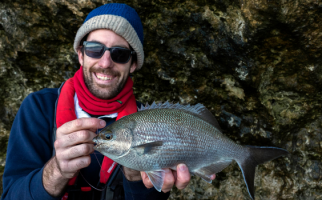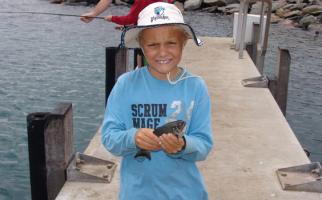Buffalo bream
Kyphosus cornelii (western buffalo bream)
Eating: One star
ID – Dark section on tail, with white colouration on extremities. Oval shaped, with silver to brownish sides.
One of the fun things about fishing is finding new ways to challenge yourself. Whether it be finding new ways to catch a species, or targeting a new type of fish, there is always fun to be had trying something new. This thrill never gets old, and has been with me since I was a kid learning to fish.
One of the first examples I can recall is as a teenager at Rottnest Island. Our family used to spend a week there every winter, and I would spend every day fishing from the shore. With a beach rod and rigs featuring either a herring blob or berley cage, I would fill in each day fishing from a rocky platform around the island. Burley was an essential ingredient each day, and I would make it myself with pollard, flour and hot water.
I’d catch countless herring, plus the occasional surprise in the form of big skippy, silver bream or even the odd King George whiting. And sometimes I would pull a squid jig out and catch a couple of them. But catching herring did start to get a bit repetitive at times and there was one species of fish that intrigued me.
I’d read eastern states fishing publications and heard about species like luderick and drummer, and often there would be several big fish in the burley trail that looked just like those drummer in the books. Eventually, I just had to try to catch them! They were, of course, buffalo bream, a rock and reef staple in the southern half of the State.

Anyone who has fished around those sorts of areas has seen buffs mooching about, often in shallow water with their tails in the air as they graze on weed growth on top of reef platforms. As a kid at Rotto, where they are extremely prolific, I wanted to see if I could catch one, but it proved a challenge as they had no interest in the bait I was using, be it whitebait or squid.
However, they were really keen on the burley so I figured I had to use that as a bait, but I obviously couldn’t keep in the hook. I started experimenting with my burley and found that by adding more flour, I could turn it into a paste of sorts, a bit like that Catchit bait you used to be able to buy at one stage.
I started burleying the buffs right to my feet and then would drop an unweighted piece of my burley paste down, with my hook buried in it. I would watch the buffs work their way through the burley trail, but somehow they seemed to know which chunk of burley had the hook in it. However, every now and then the trap would work and I’d watch a big buff inhale my offering.
I’d set the hook and all hell would break loose for a few seconds before the fish made its inevitable escape. I simply wasn’t rigged up for these big fish, and the weakest point was the small Limerick or Tarpon hook I had to use. If I went any bigger, they wouldn’t touch it as they only have small mouths, but when I did hook one, the smaller hooks would pretty much straighten immediately. Some of these fish, particularly around West End, were monsters too. I’ve never again targeted buffs since those days, but have caught a few on bait from time to time and you always think you’ve hooked something decent from the fight.

We all know buffs are horrible on the plate, but I have often wondered how much fun they might be on fly tackle, and I dare say there would be a few people out there who have tried this. They have all the prerequisites for a fly fishing target as they are common, pop up in schools close to shore and can be sight casted, plus they have great power and strength.
I’ve seen people mistake buffs for schools of salmon at times and get frustrated when these ‘salmon’ won’t look at their lures. I do know some old-school anglers who used to chase them from the moles in Fremantle for sport, using handlines as that was the only way to stop them.
Handling them is not that much fun though, as they are pretty smelly and have a tendency to expel their latest meal of algae and weed on you as a dark mess! We have two similar species in WA that most people recognise as buff bream – silver drummer and western buffalo bream and they are found in the same areas. The latter is a purely local species found only in WA as far north as Coral Bay.
Buffs grow to around 80cm and have sportfishing potential, but most anglers just let them go as you don’t want to deal with the consequences of trying to cook one. However, I did see a YouTube video the other day of local angler Deryck Tan dry aging and eating them and he said they tasted fine! Each to their own I guess!